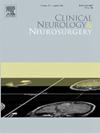Effect of arterial transit artifact in arterial spin labeling imaging on prognostic outcomes in ischemic stroke patients: A meta-analysis
IF 1.6
4区 医学
Q3 CLINICAL NEUROLOGY
引用次数: 0
Abstract
Background
Arterial transit artifact (ATA) in arterial spin labeling (ASL) imaging have been suggested to predict functional outcomes in ischemic stroke patients; however, their clinical utility remains debated. Existing studies are predominantly limited by small sample sizes, single-center designs, and low levels of evidence. Furthermore, insufficient technical standardization and methodological heterogeneity across investigations have constrained the generalizability of conclusions. This study therefore aims to evaluate the prognostic implications of ATA in ischemic stroke patients through a systematic synthesis of current evidence.
Methods
A systematic literature search was conducted across PubMed, Embase, the Cochrane Library, Web of Science, CNKI, VIP, and Wanfang databases to identify potentially eligible studies published from database inception through February 2025. Pooled effect estimates were derived using standardized mean difference (SMD) for continuous outcomes and risk ratio (RR) for dichotomous outcomes, both reported with 95 % confidence interval (CI), to quantify the association between ATA and prognostic outcomes in ischemic stroke patients. All statistical analyses were executed using STATA 17.0, adhering to Cochrane Collaboration methodological standards for meta-analytic precision.
Results
The meta-analysis incorporated 11 studies encompassing 747 participants. Pooled analyses demonstrated a significant association between the presence of ATA and favorable prognostic outcomes, evidenced by standardized mean difference (SMD = −0.91, 95 % CI: −1.13 to −0.70; p < 0.001) and risk ratio (RR = 1.43, 95 % CI: 1.22–1.67; p < 0.001). Sensitivity analyses confirmed the robustness of these effect estimates, revealing no substantial alterations upon sequential study exclusion. Publication bias assessments via Begg and Egger tests indicated no statistically significant evidence of small-study effects or publication bias.
Conclusion
This meta-analysis demonstrates a significant association between ATA and favorable functional outcomes in ischemic stroke patients, supporting their potential utility as a clinically actionable imaging biomarker for prognostic stratification.
动脉自旋标记成像中动脉传递伪影对缺血性脑卒中患者预后的影响:一项荟萃分析
背景:动脉自旋标记(ASL)成像中的物质传输伪影(ATA)被认为可以预测缺血性脑卒中患者的功能结局;然而,它们的临床应用仍有争议。现有的研究主要受到小样本量、单中心设计和低证据水平的限制。此外,调查的技术标准化和方法异质性不足限制了结论的普遍性。因此,本研究旨在通过系统综合现有证据来评估ATA对缺血性脑卒中患者的预后影响。方法系统检索PubMed、Embase、Cochrane Library、Web of Science、CNKI、VIP和万方数据库,以确定从数据库建立到2025年2月发表的潜在符合条件的研究。使用连续结果的标准化平均差(SMD)和二分类结果的风险比(RR)得出合并效应估计,两者均报告95 %置信区间(CI),以量化缺血性卒中患者ATA与预后结果之间的关联。所有统计分析均采用STATA 17.0软件进行,遵循Cochrane Collaboration的meta分析精度方法学标准。结果荟萃分析纳入了11项研究,涉及747名参与者。合并分析显示,ATA的存在与良好预后之间存在显著关联,标准化平均差异(SMD = - 0.91, 95 % CI: - 1.13至- 0.70;p <; 0.001)和风险比(RR = 1.43, 95 % CI: 1.22-1.67;p & lt; 0.001)。敏感性分析证实了这些效应估计的稳健性,显示在顺序研究排除后没有实质性的改变。通过Begg和Egger检验进行的发表偏倚评估显示,没有统计学上显著的证据表明存在小研究效应或发表偏倚。结论:该荟萃分析表明,ATA与缺血性卒中患者良好的功能预后之间存在显著关联,支持其作为临床可操作的预后分层成像生物标志物的潜在效用。
本文章由计算机程序翻译,如有差异,请以英文原文为准。
求助全文
约1分钟内获得全文
求助全文
来源期刊

Clinical Neurology and Neurosurgery
医学-临床神经学
CiteScore
3.70
自引率
5.30%
发文量
358
审稿时长
46 days
期刊介绍:
Clinical Neurology and Neurosurgery is devoted to publishing papers and reports on the clinical aspects of neurology and neurosurgery. It is an international forum for papers of high scientific standard that are of interest to Neurologists and Neurosurgeons world-wide.
 求助内容:
求助内容: 应助结果提醒方式:
应助结果提醒方式:


